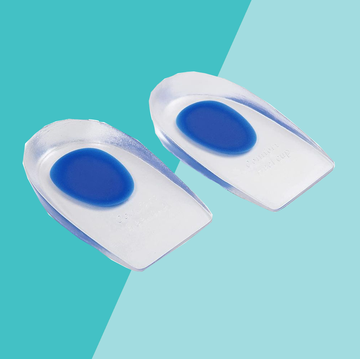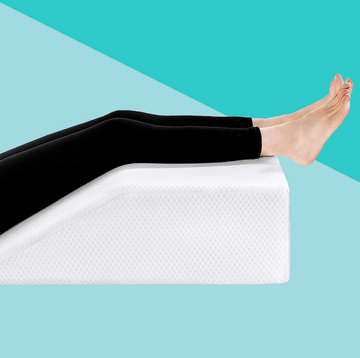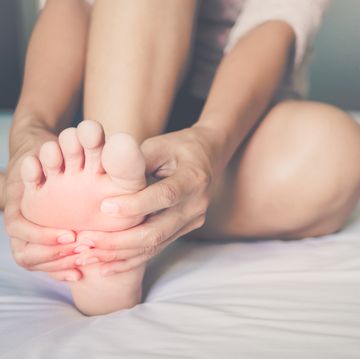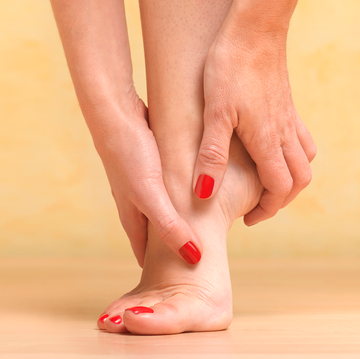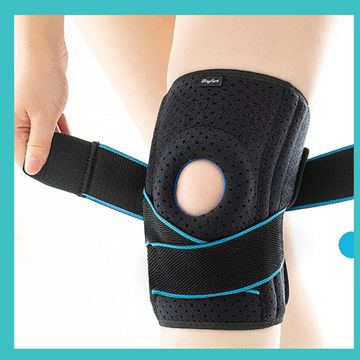If painful leg cramps at night wake you up, you’re not alone. According to a study published in American Family Physician, up to 60% of adults say they’ve experienced leg cramps at night—that special kind of muscle spasm that rudely interrupts a full night’s sleep. Keep reading to learn what leg cramps are, the common causes of nocturnal leg cramps, and possible treatments.
What are leg cramps?
Leg cramps are ill-timed Charley horses—characterized by a sharp muscle contraction that can last several seconds to minutes—that usually affect the calf and foot, although they can also strike your hamstring. “It is a sudden, sustained contraction or tightening of a muscle,” says Karena Wu, P.T., D.P.T., physical therapist and owner of ActiveCare Physical Therapy. “They are often called a ‘charley horse.’”
While we’ve all experienced a leg cramp at one point or another, they appear to be more common after age 50, shows a 2017 study in BMC Family Practice. Casey Kelley, M.D., A.B.O.I.M., integrative medicine doctor and founder and medical director at Case Integrative Health, says leg cramps at night are a common complaint. “Anatomically, they are an intense and spontaneous muscle contraction,” Dr. Kelley says. “Most are short-lived, lasting for a few seconds to a few minutes. However, once the cramp resolves the muscle may feel sore for a few days.”
Leg cramp causes
Despite how common they may be, there is not one definitive cause of leg cramps. “You will find plenty of disparate opinions, but the simple truth is that nobody really knows why these [leg cramps] occur,” says Scott Garrison M.D., Ph.D., an associate professor of family medicine at the University of Alberta who has published multiple studies on nocturnal leg cramps. There are theories, however.
Dr. Kelley says three out of four leg cramps occur at night, but why do they happen in the first place? One or several of the factors below—combined with your individual physiology—could explain why you’re waking up in pain.
Not stretching enough
Some researchers have theorized that our modern lifestyle is to blame. While our ancient ancestors spent lots of time squatting—a position that stretches leg tendons and muscles—contemporary life has mostly removed the need for it. There’s also evidence that our mostly sedentary lifestyles (spent largely in front of computers and screens) decrease muscle and tendon length and limberness, which may lead to cramping.
Sleeping in an awkward position
Other experts have observed that, when lying face down in bed, the foot is often in a “plantar flexion” position—meaning the toe points away from you, shortening the calf muscles. When the foot rests in this position for long periods, even small movements of the feet could trigger a cramp. Sleeping on your side, with your feet off the bed, or in some other position that keeps your toes neutral—not pointing away from you—may be a better position for these muscles.
Changing seasons
Dr. Garrison’s own research has shown nighttime leg cramps are more common in summer than winter. While not true for everyone, the frequency of these cramps tends to peak in mid-July and crater in mid-January. It’s important to understand that these muscle cramps are caused by nerve issues—not muscle disorders, Dr. Garrison says. Electromyogram tests have shown that nerves running from the spine down to the calf trigger these cramps.
So why summer? “Nerve growth and repair might be more active in summer because of the greater vitamin D levels,” Dr. Garrison explains. Your body produces vitamin D from sun exposure. And so in summer, when your D levels are peaking, your body may engage in “sped up” neural repair, which could trigger these cramps, he says.
Dehydration
There’s some evidence that dehydration promotes nocturnal cramping. “There is a clear seasonal pattern in the frequency of muscle cramps, with higher numbers in summer and lower numbers in winter,” says Michael Behringer, M.D., Ph.D., a professor of sports science at Goethe University in Germany. “This suggests that heat and possibly also fluid balance have an influence on the development of cramps.” Dehydration may promote electrolyte imbalances in the blood, which could be one cramp trigger.
Really tough workouts
Hard exercise has long been linked to muscle cramps. “Skeletal muscle overload and fatigue can prompt muscle cramping locally in the overworked muscle fibers,” write the authors of a study in the journal Current Sport Medicine Reports. This happens even among highly trained professional athletes, the study authors say. While staying hydrated and stretching may help, there’s no well-established method for preventing these kinds of overuse cramps.
Tight muscles
Wu says tight muscles are one of the most common causes of leg cramps. Tight and stiff muscles can be caused by exercise, especially if you are overworking your muscles, not properly stretching, or not warming up.
Nutrient deficiency
Wu also adds that mineral deficiency is one of the most prominent causes of leg cramps at any time of day. There’s evidence—although much of it is mixed—that calcium, magnesium, and potassium imbalances play a part in cramping. Each of these electrolytes helps maintain fluid balance in the blood and muscles, and so it makes some sense that, if they’re out of whack, cramping may ensue. But again, studies have been inconsistent, so more research needs to be done to know how these nutrients affect cramping directly.
Standing all-day
There’s also research showing that people who spend a lot of time each day standing are more likely to experience leg cramps than those who tend to sit more. When you’re on your feet but not in motion, blood and water tend to pool in your lower body. This may lead to fluid imbalances, as well as muscle and tendon shortening—all of which could lead to cramping.
Medications
Another of Dr. Garrison’s studies links diuretics (high blood pressure meds like Clorpres and Thalitone, for example, have diuretic effects) and asthma drugs (specifically, long-acting beta-adrenoceptors, or LABAs) to a greater risk for nocturnal cramping. It’s possible these drugs have a “stimulatory” effect on motor neurons and receptors, which could promote cramping, his study concludes.
Pregnancy
Dr. Kelley says leg cramps are more common in pregnant women, and research shows that pregnancy is associated with more frequent leg cramps, possibly due to weight gain and disrupted circulation. It’s also possible that the pressure a growing fetus places on the mother’s blood vessels and nerves causes cramping, according to the American Pregnancy Association.
Certain health conditions
Diabetes, hypertension, arthritis, neurological disease, and depression are all associated with leg cramping, too. In some cases, medications could be to blame, as mentioned above. But some of these conditions—namely diabetes and neurological disease—can disrupt or even kill your nerves, which may lead to cramping, research shows.
Aging
Aging might also play a role in leg cramping, Dr. Garrison says. “It is around the same time that we start losing our motor neurons”—roughly, our early 50s—“that rest cramps start to get more common,” he explains. Both strength and balance exercises may help maintain muscle and nervous system functioning in ways that prevent these issues, research suggests.
Nerve compression
“Nerve compression is another cause, perhaps from a pinched nerve in the back or neck,” Dr. Kelley says. According to the Mayo Clinic, a pinched nerve can be caused by surrounding tissues applying too much compression on the nerve. This can translate to numbness, aching pain, and a pins and needles sensation, all leading to cramping.
Sedentary lifestyle
Too much of anything can be a bad thing. “Sitting for prolonged periods (ie: desk jobs)…can also cause cramps,” Dr. Kelley says. Prolonged sitting can cause buildup of fluid in the legs, per the Mayo Clinic, which can lead to a cramping feeling.
Leg cramp treatments and prevention
Once you feel the twisting pain of a leg cramp while you’re in bed, you’re going to want to fix it as fast as possible, but medicine may not be the answer. Dr. Garrison says for many years, quinine pills were the go-to treatment for leg cramps. And while they provided “a modest benefit,” he says, they also caused some dangerous side effects like an irregular heartbeat. That’s why the U.S. Food and Drug Administration (FDA) advises people to steer clear of the drug to treat leg cramps.
Because there is no definitive cause of nighttime leg cramps, there’s also no sure cure. Due to this, trial and error is your best bet when it comes to leg cramp treatments. Here are a few home remedies and solutions worth considering:
Stretch
While the research on stretching goes back and forth, a small 2012 study did find that people who completed hamstring and calf stretches just before bed enjoyed a significant drop in spasm frequency.
“If the cause of cramping is from inflexibility, stretching exercises will help keep the muscles elongated and more flexible,” Wu says. “This will also help with any arterial or nerve compression as tight muscle tissues can compress these vessels.”
And if you’re in the midst of a spasm? “Stretching the affected muscle while you cramp helps abort a cramp,” Dr. Garrison says. If the cramp is in your upper leg, hamstring stretches may help. If your cramp is in your lower leg or foot, try putting weight on your leg or performing a standing calf stretch.
“Typically, getting out of bed and putting weight on it puts the muscle into a little bit of a stretch (not an excessive stretch in the opposite direction of the contraction) and can help shut the muscle tension down quickly,” Wu says. “If that doesn’t alleviate, step into a lunge position with the tight calf in the back. Place both hands on the wall for balance and lean forward keeping the back knee straight to feel a stretch in the back calf.”
Eat a balanced diet
Ensuring you have plenty of magnesium in your diet may be beneficial. Beans, nuts, whole grains, and leafy greens are all great sources. (Some research shows that this may not be helpful for everyone, though, so make sure you talk to your doctor before you make any major diet changes.)
“If [the cramps are] due to a lack of minerals, supplementation with potassium, magnesium, and calcium will help avoid muscle cramping as the body requires a balance of vitamins and minerals in the system,” Wu says.
One small study found taking B vitamin supplements could help, too. This may not be enough evidence to warrant adding it to your wellness routine, but eating more fish, whole grains, and vegetables certainly couldn’t hurt.
If you think you may have a nutritional deficiency, see a doctor to get a blood test to check your vitamin and mineral levels. A doctor or registered dietitian can recommend supplements or dietary changes.
Stay hydrated
Try to drink more water during the day—especially if it’s hot and you’re sweating or exercising. “The best way you can prevent them is by making sure you’re hydrated,” says Dr. Kelley. Dry mouth, headaches, fatigue, and dry skin are all signs that you’re not drinking enough water. The color of your urine is probably your best guide. If your pee is pale yellow or clear, you’re drinking enough H2O. If your urine is dark yellow (or closer to amber), drink up.
“[Drinking] water will help and especially hydration with electrolyte supplements, which support the mineral intake,” Wu says. Try consuming electrolyte drinks if you’re feeling dehydrated, especially if you are profusely sweating from heat or intense exercise.
Apply a hot or cold compress
If you’re in the midst of a leg cramp, “[stretching] and a hot compress is usually effective at relieving pain,” Dr. Kelley says. The Mayo Clinic recommends applying an ice pack or a heating pad (a hot towel or taking a hot bath can work too) on the muscle.
Wear proper-fitting shoes
The Cleveland Clinic recommends wearing supportive shoes that fit your feet well. Uncomfortable shoes, such as heels, or a change in footwear may cause leg cramps. So, if you’re experiencing frequent nocturnal leg cramps, it may be worth trying supportive walking shoes or visiting a podiatrist to get custom inserts for your shoes.
Massage your legs
If you’re in the midst of a particularly painful leg cramp making it too difficult to stand up and stretch, try massaging the muscle that’s cramping. The Mayo Clinic says massaging your leg can help get rid of a leg cramp, which you can do with your hands, a massage gun (use with cautio, or a foam roller.
Are there warning signs of leg cramps?
In an ideal world, you’d be able to pick up on signs before the cramp hits so that you can stop it in its tracks (or at least prevent it from becoming too painful). “Unfortunately, the hallmark of leg cramps is that they often appear suddenly and without warning,” Dr. Kelley says.
Wu agrees that there usually is no warning sign unless you notice your leg muscles feeling a bit tight. “If it is due to tightness in the tissues, the individual might already be aware that they feel very tight or have restrictions in mobility,” Wu says. However, tight muscles do not always lead to leg cramps at night, so there isn’t a true way to tell if a leg cramp is on its way.
If you know that you frequently get leg cramps or that you are at higher risk for them due to anemia, hypertension, being pregnant, exercising too much, or a sedentary lifestyle, you can take steps to prevent them. “[You] can make extra sure that you are properly hydrated and getting enough potassium, calcium, magnesium, etc.,” Dr. Kelley says. “You can also keep pain relief and treatment for leg cramps on hand, in case they do happen.”
When to see a doctor for leg cramps
Recurring leg cramps may be a sign of an underlying problem, so it’s best to have a medical professional check it out. “Your doctor can rule out any more serious causes, make any treatment recommendations, and help you address lifestyle changes that may ease the leg cramps,” says Dr. Kelley.
While a leg cramp at night isn’t typically grounds for running to urgent care, what do you do when you’ve tried all the home remedies and you continue to get leg cramps? “You should see a physical therapist if the cramping is recurring, is severe, has associated weakness, swelling, skin changes, and is not alleviated by any at-home solutions,” Wu says.
..Markham Heid is an experienced health reporter and writer, has contributed to outlets like TIME, Men’s Health, and Everyday Health, and has received reporting awards from the Society of Professional Journalists and the Maryland, Delaware, and D.C. Press Association.

